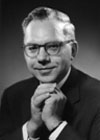 Leo Beranek, a Massachusetts renaissance man; scientist, teacher, entrepreneur, television executive, philanthropist, author, and one of the founding members of INCE, died in Westwood, Massachusetts, on October 10, 2016 at age 102 after a long and extraordinarily productive life. He leaves his wife Gabriella, sons James K. Beranek of Cedar Rapids, Iowa and Thomas B. Haynes of Chicago, Illinois and granddaughter, Antonia Hsu Haynes. He was predeceased by Phyllis Knight Beranek, his wife of 42 years.
Leo Beranek, a Massachusetts renaissance man; scientist, teacher, entrepreneur, television executive, philanthropist, author, and one of the founding members of INCE, died in Westwood, Massachusetts, on October 10, 2016 at age 102 after a long and extraordinarily productive life. He leaves his wife Gabriella, sons James K. Beranek of Cedar Rapids, Iowa and Thomas B. Haynes of Chicago, Illinois and granddaughter, Antonia Hsu Haynes. He was predeceased by Phyllis Knight Beranek, his wife of 42 years.
Leo left INCE-USA with this fascinating autobiography by his request.
A 1936 graduate of Cornell College (Iowa) with a B.A. degree in Physics and Mathematics Beranek went on to graduate school in the Applied Physics Department of Harvard University where he received his D. Sc. Degree in 1940 in the field of acoustics.
Beranek stayed at Harvard during World War II as Director of two laboratories; first the Electro-Acoustic Laboratory, which dealt with voice communication in combat vehicles, and then the Systems Research Laboratory, whose mission was to improve the U. S. Navy's ability to combat Japanese Kamikaze aircraft attacks. At the war's end President Harry S. Truman issued Beranek a "Certificate of Merit" for his contributions to the war effort.
After WWII Beranek became Associate Professor of Communication Engineering at the Massachusetts Institute of Technology where he taught courses in electrical engineering and acoustics. His seminal textbook, ACOUSTICS, was published in 1956, forever changing the teaching of acoustics to engineers.
In 1948, the acoustical consulting firm Bolt Beranek and Newman was formed with Beranek as President. Its first projects were the acoustics and sound systems in the United Nations buildings in New York, followed by NASA's jet engine test facility in Cleveland. NASA's first test of a new supersonic jet engine created such a loud noise for miles around that the City of Cleveland shut it down. Successfully solving the problem, Beranek designed and saw built the world's largest acoustic muffler, which was featured in LIFE magazine (6/11/51).
In the Fall of 1958 BBN began work for the (then called) Port of New York Authority (PNYA) which operated the JFK (then called Idlewild) airport serving New York City. Pan American Airlines had requested permission to fly the Boeing 707 (the first jet-passenger airplane) from JFK, but the PNYA said that the plane must not produce more noise in the neighborhoods around the airport than that produced by existing propeller aircraft. Beranek and his team determined that the Boeing 707 was so noisy its engines had to be equipped with heavy mufflers and follow a prescribed takeoff procedure in order to meet the PNYA's dictum.
In 1965, under Beranek's leadership, BBN became the vanguard of the digital age by putting together one of the best computer software groups in the East. In 1968 the Advanced Research Project Agency (ARPA) awarded BBN a contract to build a network to hook together 19 large-scale computers of different makes, different program languages, and in different locations. To do this BBN invented the ARPANET which consisted of 19 "Interface Message Processors (IMP's)", each of which was associated with one of the 19 main-frame computers. In the network, signals traveled from one IMP to another, and each IMP acted as the interpreter of messages that went to and from its associated main-frame computer. The first message between two IMP's and their associated computers was sent in September 1969. In 1971 BBN invented e-mail with "g" as we know it today. The ARPANET grew and when it reached about 500 users it was split in two and rejoined by the TCP/IP protocol. This occurred on January 1, 1983 and that is the official birthdate of the INTERNET. Other networks soon joined and today people around the world enjoy the fruits of this invention.
Beranek left BBN in 1969 to become President of Boston Broadcasters Inc., which, after a long court battle, took over operation of Channel 5-TV in 1972 using the call letters WCVB. The programming at WCVB was so improved that the New York Times in 1981 carried a full page article headed "Some say this is America's best TV station". The station was later sold to Metromedia.
After his foray into broadcasting, Beranek returned to acoustics. Among others, he consulted on five concert halls and an opera house in Japan. Among them was the Tokyo Opera City Concert Hall, which was hailed as an "acoustical 'miracle" on the front page of the New York Times [4/18/2000]. The Hall, which opened in September 1997, is now considered one of the five best concert halls acoustically in the world.
Beranek published 185 technical papers and thirteen books. His most recent books include:
Beranek served the Boston Symphony Orchestra as a member and chairman of the Board of Overseers and later as member and Chairman of the Board of Trustees (1968-1988). He was fulltime president of the American Academy of Arts and Sciences for five years. The alumni of Harvard University voted him a member of their senior governing body, the Board of Overseers, for six years, He also served as President of the Acoustical Society of America and the Audio Engineering Society.
Both the Museum of Fine Arts Boston and the Boston Symphony Orchestra list Beranek and his wife as major financial benefactors.
A Special Session was held during NOISE-CON 2017 to honor Leo Beranek's lifetime contributions. The presentations are available from INCE-USA: